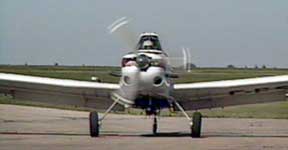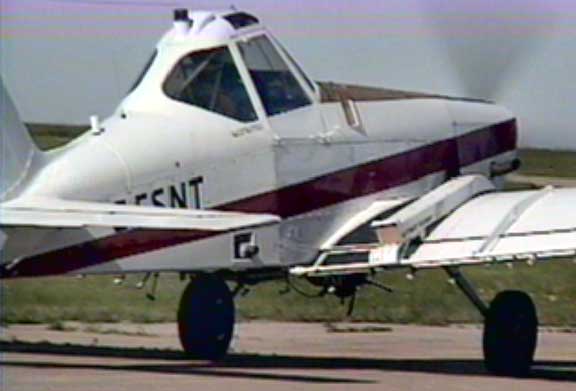|
|
|
| FTLComm - Tisdale - June 28, 2000 | |
The low temperatures throughout June has retarded the development of crops this year.
The use of aerial spraying would normally have begun about a week ago. Though some
herbacide has
been applied this morning was the first day for the application of "TILT"
the mild chemical used to control fungus on fruit and here in Saskatchewan it is
used by farmers to control the development of fungus on their malting barley crops. has
been applied this morning was the first day for the application of "TILT"
the mild chemical used to control fungus on fruit and here in Saskatchewan it is
used by farmers to control the development of fungus on their malting barley crops. |
 |
| These pictures were taken this morning at 8:30 and spraying conditions were ideal at that time. There are many factors that have to be taken into consideration when applying chemicals from the air. The wind is the main issue as the application needs to go where the pilot wants it to go and not be blown across the countryside. With TILT this is not as serious a problem since the chemical is not one of the |  |
 dangerous
poisons that needs dangerous
poisons that needsto be carefully controlled but at the same time it is costly and low wind conditions make for more efficient use of the chemical and less waste. This morning the wind was right around five knots on the surface and out in the area being sprayed (about ten miles South of town) the wind speed might have been even lower. The second factor that affects spraying is the amount of moisture available. Right before or immediately after |
|
| a rain the chemicals are reduced in their effectiveness so with the conditions we have experienced the last week or two it is almost just before or just after a rain. | |
 |
 |
| The large amounts of rain have increased the amount of fungal problems for all crops
and with wet field conditions it is expected that farmers will increasingly turn
to aerial application of chemicals if their crops become affected by moisture induced
fungus. The low temperatures have considerably reduced the danger to crops this year from insects although these sorts of problems tend to develop later in the growing season. Last year aerial application of insecticides to control Wheat Midge was fairly extensive as well as some control of aphids was needed in some canola crops. |
 |
|
|
|

